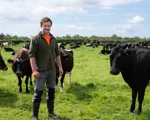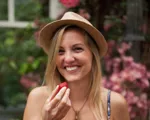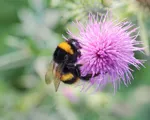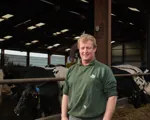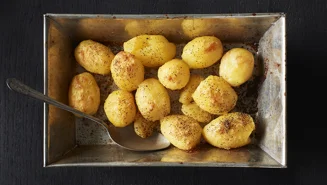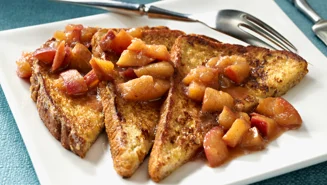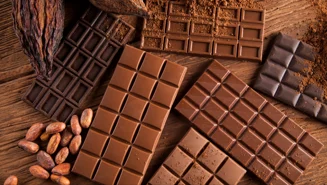
We all have our own phrases for certain things, whether you nip down the alley way, ginnel or snicket to pick your lunch of a cheese roll, bap, barm or cob – and Arla’s farmers are no different. With 2,300 dairy farms around the UK, it’s no surprise there are a number of terms for common items or events.

One is Magic Day, or Golden Day, or Balance Day, or Turning Out Day. Whatever our farmers choose to call it, it’s a big deal for them and something to celebrate. This is the day when our farmers look over their fields and see enough grass has grown (with the right density and to the right length) to ensure their whole herd can be nourished for the rest of the year by the green lushness in their fields.
Our Farmers
Our farmers also work closely with specialist bovine nutritionists to make sure their cows are fed the most nutritious diets possible, come rain or shine, in all seasons. Just as we need a varied diet to stay fit and healthy, so do cows, so special feed blends are prepared throughout the year to supplement their grass diet in the most appropriate ways.
However, from Magic Day, farmers know the grass in their fields is full of protein for their herd to graze on and some fields may be cut to prepare nutritious silage (preserved grass) for the winter months. We spoke to a couple of our farmers in different parts of the country to see what it means to them.

Arla farmer Alastair Dinsdale looks after 420 acres of farmland within the Yorkshire Dales National Park in North Yorkshire, where he grazes his herd of 200 dairy cows, along with sheep and beef cattle.
He describes his farm as a traditional Dales farm, “from the river at the bottom to the heather at the top”. The farm is brimming with wildlife including rabbits, hares and a large population of lapwing, oystercatchers and breeding Eurasian curlews, who nest in the same fields where he grows grass for silage.
“I learned how to farm alongside nature and the curlews, in particular, from my father,” says Alastair. “Sustainability and biodiversity are all a part of farming as I see it, and my dad used to say that we share the land with wildlife.”

Elevation levels on the hillside farm range from 500 to 1100 feet above sea level. The soil here is fertile, shallow and lightweight with a lot of rock and poor subsoils underneath – less than ideal conditions for growing a lot of grass. To ensure Alastair has enough grass to feed his livestock, his focus is on promoting soil health to support good quality vegetation.
“I describe our soil as delicate, but it has very good levels of organic matter,” he explains. “Our growing season starts later here due to weather conditions, but we still aim to use as much of our own grass and forage as we can. To make best use of the short growing season, we fertilise with our own cows’ manure and test our soil regularly. We also plant specific grass types in different fields that are best suited for those growing conditions.”

Alastair's cows are turned out to graze when soil conditions allow, usually by the beginning of May. To ensure that cows have enough grass to eat, Alastair regularly walks through fields to monitor grass growth, supplementing with their own silage and other food to meet the cows’ dietary needs, while also trying to avoid soya and palm products as much as he can.
“By May 15th, we have what we call ‘Magic Day’, which is when our grass growth exceeds what our cows will need to eat,” he continues. “That means that we can now start putting grass away and build our reserves up for the winter or whatever challenge comes next.
“If we were in a different area, we would be able to grow more energy-dense crops for our cows, like maize or fodder beet, but here in the Dales that isn’t an option,” continues Alastair. “We rely on good quality grass all year round, which means we start putting grass into silage and hay to build up our reserves for when the cows can’t graze enough themselves. It’s a good day for the farm!”

Unlike Alastair, George Brown is new to farming. He farms on the edge of the New Forest in Hampshire. He has been involved in the farm for two years, as part of a share farming arrangement. The farmland covers a range of different types of land from the forest down to the River Avon plain and beyond, with river meadows and wetland areas, managed to encourage and protect breeding wader birds.
The climate on the south coast is ideal for grass growing and George is striving to grow as much of the food for his 550 cows on the farm as he can.
“Our cows graze on the grass in the summer months with additional grass, maize and fodder beet grown to feed the animals through the winter. Providing a nutrient balance for the cows that is just right, with optimum amounts of protein and butterfat to make milk is a complicated job.”
Traditionally, much of the protein for his cows has come from bought-in feed but over the past 18 months, George has re-seeded over the half the farm with carefully chosen grass mixes containing lots of red clover, providing a homegrown source of protein for the cows. The clover is also more tolerant to drought and continues to grow when the grass slows up in drier weather.
“On this farm, we get really excited about growing grass” says George. “In the spring and summer seasons we measure it weekly with a special tool called a plate meter, as well as monitoring is using satellite mapping software. ‘Magic Day’ or ‘Balance Day’ is a milestone time of the year where the amount we are growing each day exceeds what the cows are eating each day – it means we can then start saving fields to cut for hay or silage for winter feed. You’ll know when we’ve reached it because it’s the same time as when you need to start cutting your lawn once a week!”

But George’s farm isn’t just about growing as much feed as possible. There are large areas of wetland on the farm that are managed as a nature reserve. These areas are held back from grazing until late summer, as part of an initiative in the Avon Valley to support breeding wader birds including lapwing and redshank.
“We’ve currently got electric fences dotted all around the river meadows protecting individual birds’ nests, to prevent foxes from eating the chicks,” explains George. “Later in the summer, once the chicks have fledged, we’ll graze the area lightly with just a few animals – it’s about managing habitats and working in harmony with wildlife.”









